| Version française |
BMP-3 IFV
Tracked Armored Infantry Fighting Vehicle - Russia
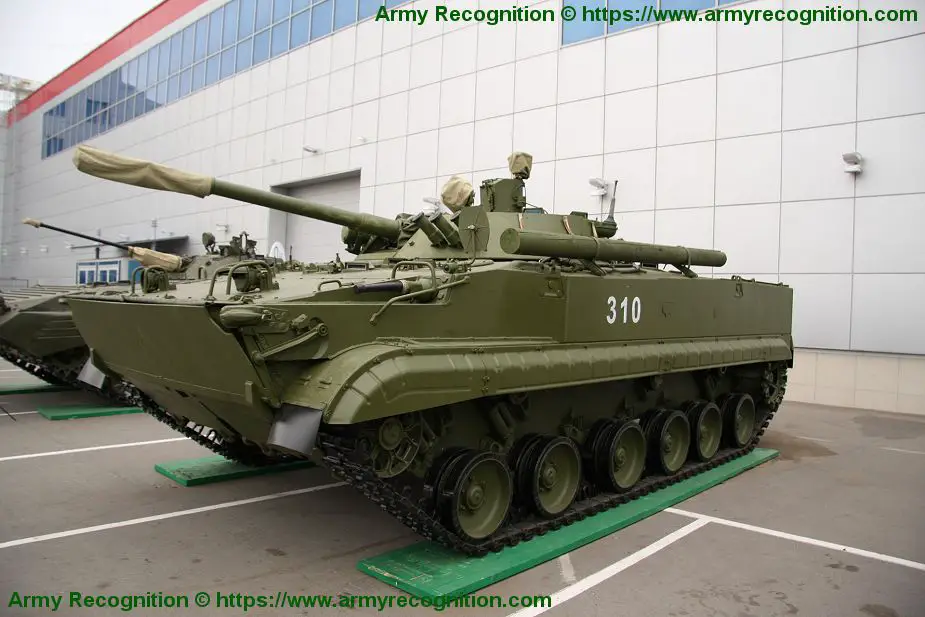
Description
The BMP-3 is a Russian-made tracked amphibious infantry fighting vehicle, a successor to the BMP-1 and BMP-2, which entered service with the Soviet army in 1990 and made its first public appearance the same year. Kurganmashzavod of Kurgan, Russian Federation manufactures the chassis and the Instrument Design Bureau (KBP) of Tula is responsible for the turret. It is a tracked, armored, amphibious vehicle designed to engage armored ground and air targets while stationary, on the move, and afloat. The first export customer was Abu Dhabi, part of the United Arab Emirates, which placed an initial order for 330 vehicles that were delivered between 1992 and 1995. These vehicles have a number of modifications to meet the specific operational requirements of Abu Dhabi, with some of the vehicles being fitted with a Namut thermal sight which includes a thermal camera mounted on the left side of the turret rear and provide a thermal view for the gunner. In September 2015, the Russian defense industry announced that Iraq had a plan to acquire 500 BMP-3 tracked armored IFVs (Infantry Fighting Vehicles) from Russia. According to the SIPRI (Stockholm International Peace Research Institute) Arms Transfers Database, Iraq ordered 300 BMP-3 IFVs in 2015 that were delivered in 2018-2019.
BMP-3 IFV variants:
-BMP-3M - KBP and Kurganmashzavod have upgraded the vehicle with a new turret and engines. The upgraded vehicle is called the BMP-3M and the new turret includes a new automatic fire control system with a digital computer, a new BZS1 gunner's sight with SAGEM thermal imager and laser illuminator, TKN-AI commander's periscope with laser infrared illuminator, and new ammunition loading system. The BMP-3M will also be able to fire ammunition types including new 100 mm laser-guided projectiles, new 100 mm HE-FRAG (high explosive fragmentation) rounds and new 30 mm APDS (armor-piercing discarding sabot) rounds. Additional passive armor protection is effective against 12.7 mm armor-piercing rounds from a range of 50m. Explosive reactive armor is available as an option. The new uprated engine is the UTD-32, which is rated at 660hp. There are actually several different M models, some fitted with additional armor, "Arena-E" or "Shtora-1" protection system, air conditioner, etc. The latest version is also known as BMP-4 and is fitted with the "Bakhcha-U" turret from the BMD-4. It entered state trials in 1999.
- BMMP (bojevaya mashina morskoj pekhoti) - Version for naval infantry, fitted with the turret of the BMP-2.
- BMP-3K (komandnyi) - Tactical command variant, includes additional radios R-173, an AB-1 APU, a navigation device TNA-4-6 and the "Ainet" round fuzing capability. The BMP-3K lacks the bow machine guns and has its whip antennas mounted on the rear hull. Crew: 3+3.
- BMP-3F - Specially designed for operations at sea, with improved seaworthiness and buoyancy, and high fire accuracy at sea force 2. This can endure continuous amphibious operation for seven hours.[5]
- BRM-3K "Rys" (Ob.501) (boyevaya razvedivatel'naya mashina) - Reconnaissance variant with 1PN71 thermal sight (3.7x/11x, 3 km range), 1PN65 second-generation image intensifier (7x, 1.2-1.5 km range), 1RL-133-1 ("TALL MIKE") I-band surveillance radar (3 km man, 12 km vehicle), 1V520 computer and a TNA-4-6 navigation system. The armament consists only of the stabilized 30 mm gun 2A72 (600 rounds) and a coaxial 7.62 mm machine gun (2,000 rounds). Combat weight: 19 t, crew: 6. Photos[dead link]
- BREM-L "Beglianka" (Ob.691) (bronirovannaya remontno-evakuatsionnaya mashina) - Armoured recovery vehicle with a five-tone crane and 20/40 metric ton capacity winch. Photos
9P157 "Krizantema-S" - Anti-tank version with two supersonic 9M123 Khrizantema (AT-15) missiles. Photos
- 9P162 "Kornet-T" - Anti-tank version with 9M133 Kornet (AT-14) missile system.
- 2S31 Vena - Fire support vehicle with a 120 mm mortar
- DZM "Vostorg-2" (dorozhno-zemlerojnaya mashina) - Combat engineer vehicle with a dozer blade and excavating bucket. Prototype.
- UR-93 (ustanovka razminirovaniya) - Mine clearing system. Prototype.
- UNSh (unifitsirovannyj shassi) - Basic chassis for specialized variants.
- KhTM (khodovoj trenazhor) - Driver trainer.
- Hermes - Air-defence vehicle with high-velocity missiles and radar system. Prototype.
Technical Data
| Armament |
|
The main armament of the BMP-3 consists of one 100mm 2A70 semi-automatic rifled gun/missile launcher, which is stabilized in two axes and can fire either 3UOF HE-FRAG rounds or 3UBK10 anti-tank guided missiles. The effective range for the HE-FRAG round is 4,000m. Muzzle velocity is 250m/s. 22 HE-FRAG rounds can be carried in the automatic loader, total ammunition load is 40 rounds. The rate of fire is ten rounds a minute. The gun fires the 3UBK10 anti-tank guided missile round, which consists of the 9M117 laser beam riding missile and container. This missile is used in the Bastion missile system (Nato designation AT-10 Stabber). It can engage tanks with explosive reactive armor as well as slow, low-flying targets such as helicopters. The BMP-3 is fitted with an automatic fire control system with manual override for both the gunner and the commander. It includes a 1V539 ballistic computer, a 2E52 electro-mechanical armament stabilizer, and a 1D16 laser rangefinder. The second armament includes one 30 mm 2A72 coaxial cannon and one 7.62 mm PKT coaxial machine gun. The dual-feed 30 mm 2A72 cannon can engage ground targets at ranges of 1,500 to 2,000 m and helicopters out to 4,000 m. It can fire a full range of ammunition such as AP-I, HE-I, and HE-T. Three smoke grenade dischargers are mounted on each side at the front of the turret. One 7.62 mm PKT machine gun is mounted on either side of the hull, firing forwards and these are operated by one of the front three crew members.
|
| Design and protection |
|
The hull and the turret of the BMP-3 are of welded aluminum, which provides protection against the firing of small arms caliber and shell splinters of the battlefield. The hull floor of the BMP-3 consists of two layers with a space between them and, over the frontal arc of the turret, spaced armor is fitted as standard. The BMP-3 has a crew of three including a commander, gunner, and driver. A total of seven infantrymen can be carried on either side of the driver with the remainder being seated to the sides and rear of the turret. The troop compartment is at the rear of the hull with entry via two doors in the hull rear opening left and right, with the left door having a firing port. As these doors are opened steps automatically fold down.
|
| Mobility |
| The BMP-3 is motorized with a V-shaped UTD-29 diesel engine, which produces 500hp. mounted at the rear of the vehicle, coupled with a hydromechanical transmission, with 4 forward and 2 reverse gears. The suspension on either side consists of six dual rubber-tired road wheels with the idler at the front, drive sprocket at the rear, and three track return rollers. The roadwheels have individual hydropneumatic suspension, which consists of a spring, shock absorber, and an elevation device that allows the ground clearance to be adjusted from 190 mm to 510 mm. An external shock absorber is attached to the first, second, and sixth roadwheel stations. The BMP-3 vehicle weighs 18.7 tons and is capable of a maximum speed of 70 km/h and a range of 600 km on roads. |
| Accessories |
| The BMP-3 is fully amphibious and is propelled in the water by two water jets at the rear of the hull. Before entering the water a trim vane, which is stowed on the glacis plate when not in use, is erected at the front of the hull. Standard equipment includes the capability to lay a smoke screen by injecting diesel fuel into the exhaust outlet, an NBC system, and a dozer/entrenching blade fitted at the front of the vehicle. The BMP-3 has a fire detection/suppression system in the front and rear crew compartments, turret, and engine compartments. Optional equipment includes an air conditioning system for use in hot climates and thermal night vision equipment, which is covered under variants. |
Specifications
| Armament | Armor |
| One 100 mm gun, one 30 mm gun, and three 7.62 mm machine guns | Welded aluminum alloy, protection against small arms caliber and shell splinters. |
| Country users | Weight |
| Azerbaijan, Cyprus, Indonesia, Iraq, Kuwait, Libya, Morocco, Nicaragua, Russia, Sri Lanka, South Korea, Turkmenistan, United Arab Emirates, and Venezuela. | 18,700 kg |
| Designer Country | Speed |
| Russia | 70 km/h on the road, 10 km/h on water |
| Accessories | Range |
| Fire control system, night vision, NBC protection system | 600 km |
| Crew | Dimensions |
| 3 + 7 infantrymen | Length: 7.14 m; Width: 3.23 m; Height: 2.65 m |
Details View
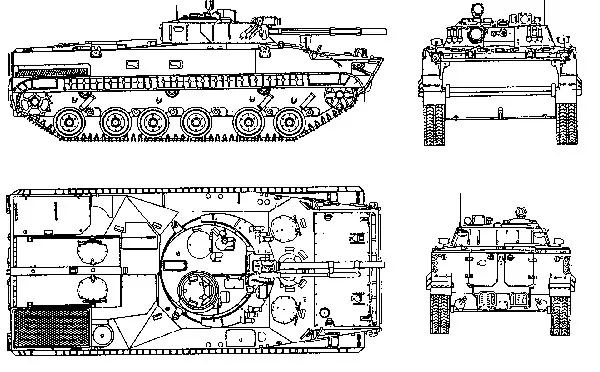 |
|
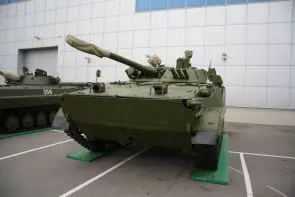 |
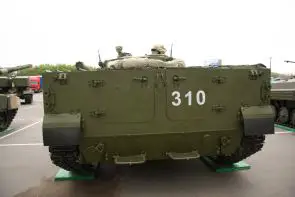 |
| a | |
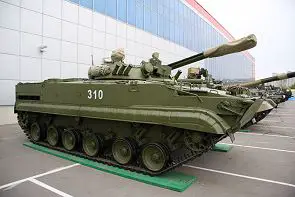 |
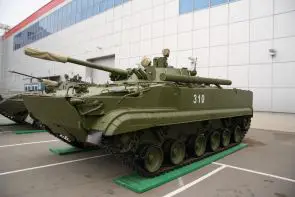 |
Pictures - Video















